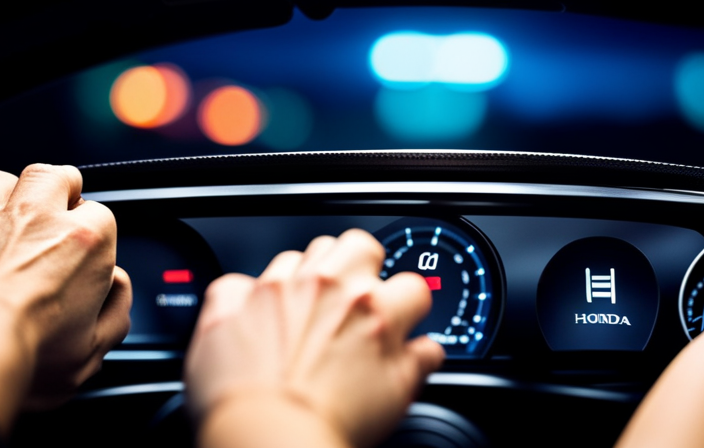Beginning my adventure on the open road, the gentle hum of the engine coupled with the breeze tousling my hair brings a feeling of exhilarating freedom and excitement. However, this excitement is quickly dampened by a troubling sight on my dashboard – the dreaded check engine light, interrupting the moment. Adding to the confusion, this warning only appears when I engage the cruise control feature.
What could be causing this mysterious interaction?
In this article, I will delve into the intricacies of the check engine light and how it relates to the functionality of cruise control. Together, we will explore the possible culprits behind this perplexing issue and discuss the steps to diagnose and resolve it.
Whether you’re a seasoned driver or a novice, understanding the inner workings of your vehicle is crucial for a smooth and safe journey. So let’s dive into the technical details, arm ourselves with knowledge, and unravel the mysteries behind the check engine light’s peculiar behavior when cruise control is engaged.
Key Takeaways
- The check engine light may come on when using cruise control due to various issues such as a faulty oxygen sensor, loose or damaged gas cap, worn-out spark plugs, or a malfunctioning throttle position sensor.
- It is important to take action by checking the gas cap for a tight seal, inspecting vacuum hoses for leaks or damage, and checking the throttle body for carbon buildup or malfunctioning components.
- If the issue persists, it is recommended to seek professional help for a thorough diagnosis and accurate identification of the problem.
- Understanding the costs involved, including diagnostic fees, parts replacement, and labor charges, is crucial for budgeting and decision-making when it comes to fixing the check engine light issue.
Understanding the Check Engine Light
If your check engine light is coming on when you’re using cruise control, you need to understand what it’s trying to tell you. The check engine light is an indicator that something is not functioning properly in your vehicle’s engine system.
It could be a result of a sensor malfunction or other issues that need troubleshooting. To determine the cause, you can use a diagnostic code reader to interpret the codes stored in your vehicle’s onboard computer. These codes provide specific information about the problem, such as which sensor is malfunctioning or the nature of the issue.
Once you have identified the problem, you can take the necessary steps to fix it and ensure that your cruise control functionality is not affected.
Cruise Control Functionality
Cruise control works by automatically maintaining a constant speed set by the driver. When engaged, it uses sensors to monitor the vehicle’s speed and adjusts the throttle as necessary to keep the desired speed.
This allows the driver to relax their foot on the accelerator pedal, reducing fatigue and improving fuel efficiency.
How does cruise control work?
Cruise control works by utilizing several components and systems. Here is a breakdown of its functionality:
-
Speed Sensor: The cruise control system relies on a speed sensor to determine the current speed of the vehicle. This sensor continuously monitors the speed and sends the information to the control module.
-
Actuator: An actuator is responsible for controlling the throttle. When the cruise control is activated and a desired speed is set, the actuator adjusts the throttle position to maintain that speed. It ensures that the vehicle maintains a steady speed without the need for constant pressure on the accelerator.
-
Control Module: The control module serves as the brain of the cruise control system. It receives input from the speed sensor and other components, such as the brake pedal switch, to maintain the set speed. The module processes this information and sends signals to the actuator to adjust the throttle accordingly.
Mastering cruise control troubleshooting and maintenance is essential to ensure optimal performance and longevity of the system. Understanding how these components work together allows for effective diagnosis and repair of any issues that may arise.
Now that we have explored how cruise control works, we can delve into the benefits of using this feature and its potential impact on the check engine light.
Benefits of using cruise control
Using cruise control on long road trips offers a range of benefits. One major advantage is the cost-effectiveness it brings. By maintaining a consistent speed, cruise control helps to optimize fuel efficiency, reducing the amount of fuel consumed during the journey. This can result in significant savings at the pump, especially on longer trips.
Additionally, the steady speed provided by cruise control can also contribute to a smoother driving experience and reduce wear and tear on the vehicle’s components.
However, it’s important to note that there may be possible interactions between cruise control and the check engine light, which we will explore in the next section.
Possible Interactions between Cruise Control and Check Engine Light
When discussing possible interactions between cruise control and the check engine light, there are two key points to consider: sensor malfunctions and electrical issues.
Sensor malfunctions can occur when the cruise control system receives incorrect or inconsistent data from various sensors. This can lead to the check engine light being triggered. It is important to address these sensor malfunctions promptly to ensure the safe and efficient operation of the cruise control function.
Electrical issues, on the other hand, can arise from faulty wiring or connections within the cruise control system. These issues can cause the check engine light to illuminate as a result. It is crucial to address any electrical issues as soon as possible to prevent further damage and ensure the proper functioning of the cruise control system.
In conclusion, both sensor malfunctions and electrical issues can potentially affect the interaction between cruise control and the check engine light. Promptly addressing these issues is essential for maintaining the safe and efficient operation of the cruise control function.
Sensor malfunctions
The check engine light illuminates as the cruise control is engaged, indicating a potential malfunction in the sensors. Sensor malfunctions can occur due to issues such as sensor calibration errors or outdated software. To better understand the possible causes, let’s examine a table that highlights the relationship between sensor malfunctions and cruise control activation:
| Sensor Malfunction | Cruise Control Activation |
|---|---|
| Sensor calibration errors | Check engine light illuminates |
| Outdated software | Check engine light illuminates |
It is important to note that these malfunctions can disrupt the proper functioning of the cruise control system, leading to potential safety concerns. As we move on to the next section on electrical issues, it is crucial to address these sensor malfunctions promptly to ensure the overall reliability of the vehicle’s electrical systems.
Electrical issues
When a check engine light comes on while using cruise control, it can be a sign of sensor malfunctions or electrical issues.
In the case of electrical issues, there could be a problem with the wiring or connections that are affecting the proper functioning of the cruise control system.
Troubleshooting steps for this subtopic include:
- Checking the cruise control fuse
- Inspecting the wiring for any damage or loose connections
- Testing the cruise control module for proper voltage
It is important to address electrical issues promptly, as they can not only impact the functionality of the cruise control system but also affect fuel efficiency.
By resolving these electrical issues, you can ensure a smooth and efficient driving experience.
Moving forward, let’s delve into diagnosing the issue further.
Diagnosing the Issue
To diagnose the issue, you’ll need to figure out what’s causing the check engine light to come on while using cruise control. One possible reason could be a sensor malfunction or electrical problems. To help you understand the potential causes, here is a table that outlines some common sensor malfunctions and electrical problems that could trigger the check engine light:
| Sensor Malfunction | Electrical Problems |
|---|---|
| Oxygen Sensor | Loose or corroded wires |
| Mass Airflow Sensor | Faulty ignition switch |
| Throttle Position Sensor | Blown fuse |
| Engine Coolant Temperature Sensor | Faulty alternator |
| Knock Sensor | Defective battery |
By analyzing these possibilities, you can narrow down the potential culprits that could be triggering the check engine light. Moving forward, let’s explore the common culprits that may cause these sensor malfunctions or electrical problems.
Common Culprits
Let’s uncover the usual suspects behind these sensor malfunctions and electrical problems. When it comes to the check engine light coming on while using cruise control, there are several common culprits that could be causing the issue. Here are some troubleshooting steps to consider:
-
Faulty oxygen sensor: A malfunctioning oxygen sensor can disrupt the air-fuel mixture, triggering the check engine light.
-
Loose or damaged gas cap: A loose or damaged gas cap can cause a vapor leak, leading to an illuminated check engine light.
-
Faulty spark plugs or ignition coils: Worn-out spark plugs or faulty ignition coils can result in misfires, triggering the check engine light.
-
Faulty throttle position sensor: A malfunctioning throttle position sensor can affect the cruise control system, causing the check engine light to come on.
By identifying these common culprits, you can take the necessary action to resolve the issue and get your cruise control working smoothly again.
Taking Action
By addressing these common culprits, you can swiftly resolve the issue and regain the smooth functionality of your cruise control.
When the check engine light comes on while using the cruise control, it is important to identify warning signs and apply troubleshooting techniques.
First, check the gas cap to ensure it is tightly sealed. A loose gas cap can cause the check engine light to illuminate.
Next, inspect the vacuum hoses for any leaks or damage. Faulty hoses can disrupt the vacuum system, leading to the check engine light turning on.
Additionally, check the throttle body for any carbon buildup or malfunctioning components. Cleaning or replacing the throttle body may be necessary.
Lastly, if none of these steps resolve the issue, it may be time to seek professional help for a more in-depth diagnosis.
Seeking Professional Help
When the check engine light comes on while using cruise control, it’s important to consult a mechanic to diagnose the issue. A professional will have the necessary expertise and tools to accurately identify the problem and recommend the appropriate repairs.
Understanding the costs involved is also crucial before proceeding with any repairs, as it allows for better budgeting and decision-making.
When to consult a mechanic
If your check engine light comes on while using cruise control, you should definitely consider consulting a mechanic to ensure your vehicle is in proper working condition. When it comes to addressing this issue, there are a few factors to consider before attempting any DIY fixes.
First, evaluate the severity of the problem by looking for signs of a serious issue, such as unusual noises, loss of power, or excessive smoke from the exhaust.
Next, assess your own mechanical skills and knowledge. If you are not experienced with diagnosing and repairing complex engine problems, it is best to leave it to the professionals.
Lastly, consider the potential risks of not addressing the problem promptly, as it could lead to further damage and costly repairs down the line.
Understanding the costs involved, let’s delve into the next section.
Understanding the costs involved
Understanding the costs involved in addressing this issue is crucial to making an informed decision about consulting a mechanic. A cost analysis will help determine the financial implications of getting the check engine light fixed when using cruise control. To provide a clearer picture, let’s examine a table that outlines the potential expenses associated with this problem.
| Cost | Description |
|---|---|
| Diagnostic Fee | Fee charged by the mechanic to identify the issue |
| Parts Replacement | Cost of any necessary parts that need to be replaced |
| Labor Charges | Fee for the mechanic’s time and expertise in fixing the problem |
| Additional Repairs | Any additional repairs that may be needed after diagnosing the issue |
By considering these costs, you can weigh them against the potential benefits of getting the check engine light fixed. It’s important to note that preventive measures can help avoid costly repairs in the future, so let’s explore those next.
Preventive Measures
To avoid potential issues, it’s crucial to take preventive measures when using cruise control and experiencing the check engine light coming on. Preventing damage is essential, and there are a few troubleshooting steps you can take.
First, check the gas cap to ensure it is tight and properly sealed. A loose or faulty gas cap can trigger the check engine light.
Next, inspect the throttle body for any dirt or debris. A dirty throttle body can lead to improper airflow and trigger the light.
Additionally, regularly servicing your vehicle, including oil changes and air filter replacements, can help prevent issues.
By following these preventive measures, you can minimize the chances of encountering a check engine light while using cruise control.
Now let’s move on to discussing safety precautions for using cruise control.
Safety Precautions
When whirling through the waves of the highway on your magical motorboat, it’s essential to mind the safety measures that will safeguard your smooth sailing. To prevent accidents and maintain optimal vehicle performance, here are some safety precautions to consider:
- Regularly check your tires for proper inflation and tread depth to ensure good traction on the road.
- Keep a safe following distance from the vehicle ahead to allow for ample reaction time.
- Always use your turn signals to communicate your intentions to other drivers.
- Maintain a consistent speed while using cruise control to avoid sudden changes that may lead to loss of control.
- Ensure that your brakes are in good working condition and react promptly to any warning signs, such as unusual noises or decreased responsiveness.
By following these safety measures, you can reduce the risk of accidents and ensure that your vehicle performs at its best.
Moving forward, let’s delve into the conclusion and final thoughts on this topic.
Conclusion and Final Thoughts
In conclusion, after discussing the safety precautions to take when the check engine light comes on while using cruise control, it is important to consider potential solutions and final recommendations.
When the check engine light illuminates during cruise control operation, it is crucial to address the issue promptly to ensure the vehicle’s safety and performance. Firstly, it is recommended to consult the vehicle’s owner’s manual for specific instructions on how to proceed.
Additionally, seeking professional assistance from a certified mechanic or authorized dealership is highly advised. They possess the expertise and diagnostic tools necessary to accurately identify and resolve the underlying problem.
It is essential not to ignore the check engine light, as it can indicate serious issues that may compromise the vehicle’s overall functionality. Regular maintenance and timely repairs are key to preventing further damage and ensuring a smooth driving experience.
By adhering to these final recommendations and promptly addressing any check engine light concerns, drivers can maintain the safety and reliability of their vehicles.
Frequently Asked Questions
What does it mean if the check engine light comes on while using cruise control?
Possible causes for the check engine light while using cruise control include issues with the throttle position sensor, vacuum leaks, or a malfunctioning cruise control module. To diagnose and fix these problems, a thorough inspection and testing of the components involved is necessary.
Can I continue using cruise control if the check engine light is on?
When the check engine light is on, it can negatively affect fuel efficiency when using cruise control. Additionally, the check engine light can cause the cruise control to malfunction, making it unsafe to continue using.
Is it safe to drive with the check engine light on while using cruise control?
Driving with the check engine light on while using cruise control is not safe. Safety concerns may arise due to potential underlying issues. Possible causes include a faulty sensor or engine misfire, and solutions should be sought immediately to prevent further damage.
Are there any specific warning signs or symptoms that may indicate a problem with the cruise control system when the check engine light is on?
Warning signs and symptoms of a faulty cruise control system include sudden disengagement, erratic speed control, and complete failure to engage. These issues should be addressed promptly to ensure safe operation of the vehicle.
Are there any potential risks or damages that could occur if I ignore the check engine light while using cruise control?
Ignoring the check engine light while using cruise control can lead to potential engine damage. The consequences of neglecting this warning include further deterioration of engine components, reduced performance, and increased repair costs.
Conclusion
So, in a nutshell, when you’re cruising along with your trusty cruise control engaged, if that pesky check engine light decides to make an appearance, it’s not the end of the world.
It just means that your car’s computer has detected a potential issue and wants you to give it some attention.
By diagnosing the problem and taking preventive measures, you can ensure a smooth and hassle-free ride in the future.
Just remember to stay safe on the roads and keep that engine purring like a content kitten.










